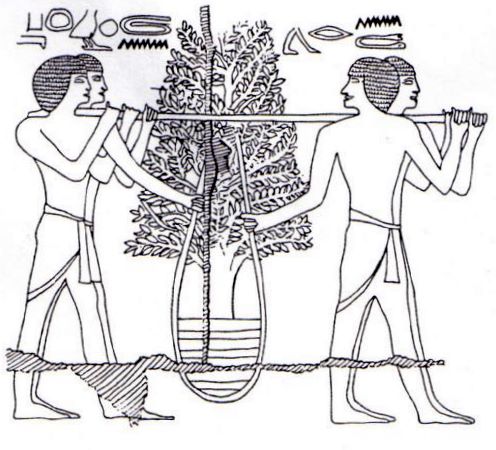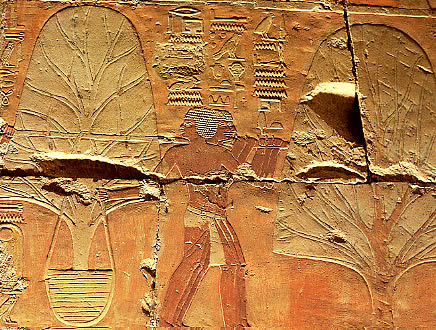|
REMBRANDT & BONSAI?
"[T]here is a painting by Rembrandt van Rijn, dated c.1665, variously titled The Bridal Couple, Ruth and Boaz or The Jewish Bride, which appears to depict a bonsai in an Amsterdam garden. "The painting shows a couple standing outdoors before a wall. (Their garb is apparently contemporary Dutch.) On the right, in a niche in the wall, is what could be a twin-trunk tree with flowering ground cover planted in an unglazed, square (or rectangular), brown container with a lip and cloud feet. On the left, there is a hanging planter, and, beneath that, some plants in a round, straight-sided, three-footed, ceramic pot. Both the container in the niche and the one on the ground seem unlike European pottery of the 17th century or earlier. "By the 1660's, the Dutch had been trading heavily with several areas in the Orient for approximately a century, and had an exclusive (European) trading agreement with the Japanese government, dating from 1641, to use the port of Nagasaki. It is, therefore, quite possible that dwarfed trees in pots from China and/or Japan were included in the cargoes the traders brought home. "The reason for the uncertainty about the contents of the picture is Rembrandt's chiaroscuro style. He focuses most of the light on the main subjects, and leaves surrounding items in relative obscurity. Consequently, it is difficult to determine with assurance from color reproductions exactly what is being portrayed in the background. However, the apparent bonsai pot, plus the ready access to all manner of Oriental goods, coupled with the Dutch interest in exotic plant forms, while not dispositive, strongly suggest that the plant in the niche is a seventeenth century bonsai.
"The painting is in the collection of
the Rijksmuseum in Amsterdam..."
As it turns out, a co-worker of RJB just
so happened to be going to Amsterdam in late July of 2002 as part of a
European vacation. She took with her a copy of the above article
and a b&w photo of the painting after receiving a crash course in bonsai.
She and her family were able to inspect the actual painting at the Rikjmuseum
and returned with a quality postcard from that establishment. This
reproduction measures 4-1/8 x 5-13/16" [10.4 x 14.7 cm]. Scanned
and pasted below, it shows even more detail than one can see in either
of two coffee-table-sized library books reviewed of the artist's works.
The subject tree portion of the above, plus three manipulations by RJB of the lighting to emphasize the plant and pot, are shown below.
The actual canvas painting
measures 48 x 65-1/2" (121.5 x 166.5 cm)-- no small work. "As far
as is known, the first mention of this picture is in the seventh volume
of John Smith's
Catalogue Raisonné... (London, 1834; item
430), where it is called 'The Birth-day Salutation.' Smith ...praises
the painting extravagantly and says he bought it in 1825 from 'Mr. Vaillant'
of Amsterdam for five thousand guilders. In 1833 he sold it for 6825
guilders to the Amsterdam collector Adriaan van der Hoop... Of the
biblical figures suggested as the subjects, Isaac and Rebekah or Jacob
and Rachel seem the most likely. The identification with the first-named
rests upon a drawing [pen and bistre, approx. 5-3/4 x 7-3/8" (14.5 x 18.5
cm)], presumably dating from about 1655, in which Isaac and Rebekah are
spied upon by King Abimelech."
POSSIBLE EXPLANATION AFTER ANOTHER VIEWING? The "pot" is actually the top portion of a
deeper vessel. The "bottom" of the alleged bonsai container is actually a decorative edge for a tall vessel which
continues to narrow below this "bottom" and descends into deeper shadow. This taller pot rests on a surface that visually
seems to be about where the right-hand edge of the woman's red dress folds sharply down to the left and also in line with the tip of her right
small finger (pinkie). The container's bottom might be in line with the top edge of her right hand. The four partial sections,
including three light-manipulated pictures, below the full image, thus, do not include the actual lower portion of the container. As an additional tease, RJB has come upon a portrait from the same era by a lesser Dutch artist of a burgher and his Eurasian wife. Jacob Jansz Coeman actively painted in 1651-1676, from 1663 until the end of his life he was active in Batavia (Indonesia). Pieter Cnoll & family (1665, currently also in the Rijksmuseum) shows the subject with a half Japanese wife. The detail of the work as shown does not have any other remarkable features. The full picture is being sought. NOTES
Haak, Bob
Rembrandt His Life, His Work, His Times
(New York: Harry N. Abrams, Inc.; 1969.
Translated from the Dutch by Elizabeth Willems-Treeman), pp. 320-322, from
whence came the above quote. Color on pg. 320; b&w of the drawing
on pg. 322. On pg. 334 Haak also states "At last Rembrandt's art
reached its ultimate perfection in the one picture which I place at the
very pinnacle of his art:
The Bridal Couple." Although the
late date of discovery of this work might raise some concern, the fact
the both the Rikjmuseum and various authors accept this fine work into
Rembrandt's opus seems to settle any question of its authenticity.
Besides, if a forger was to have produced such a celebrated work, that
person surely must have left some other proof that his/her talents vied
with the Dutch master's best!
|

